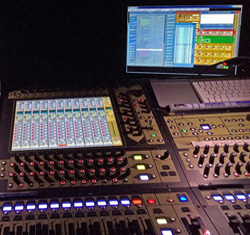
Hybrid Mix
This method is like a board mix, but it does differ. Basically, it involves taking the inputs and splitting them up into groups. These groups don’t go to the main L/R bus, but rather, feed into the matrix mix of the console.
Inside the matrix, they’re combined at the proper level so that when they come out, it feels right. We’ll talk more about that in a bit.
How the inputs are arranged into groups will depend on the band and your equipment. Currently, I’m using two mono and three stereo groups, and I also add several direct channels for walk-in music and audience mics. The beauty of this approach is that each element of the service is level-balanced to the correct perceived volume.
Different processing is also available at each stage of the mix. This provides more control and keeps the processing more transparent.
Design Goals
I had several goals in seeking to create a high-quality broadcast mix. First, I wanted it to sound good, even when I’m not mixing FOH. Second, the process has to be pretty seamless, and must work regardless of who is at the console.
Third, I wanted to create an accurate representation of what’s happening in the room – capturing the live energy is important to me. Finally, I wanted to do as little post production on the mix as possible, and doing the hard work up front helps in achieving this goal.
In The Grouping
What follows is my approach, which I offer here to get you thinking. This is descriptive, not prescriptive. The worship team splits into two groups, stereo band and stereo vocals. I typically add an extra 1-2 dB on vocals, which helps them stand out on video. I also do a little compression on each group.
A mono speaking mic group includes the pastor, plus any interview or announcement mics. Another stereo group handles playback of videos and the occasional Skype interview. A recent addition is what I call “Worship Leader Speaking.” When the leader talks during the worship set, it’s usually a lot quieter. This works in the room but feels (sounds) weird on video, so this mono group gives a little boost when they talk. Snapshots or macros are used to get those inputs in and out of the group.
Finally, a stereo pair of mics in the house picks up the audience and some ambience. The walk-in music playback channel is also routed straight to the matrix at the appropriate level. Because it’s post-fade, our opening transition is now cleaner.
On The Level
As noted earlier, it’s not uncommon to see a dynamic range of 30 or more dB (SPL) in a typical service. Speaking mics might run in the mid to high 60s, while music may be anywhere between the mid 80s to the low 100s (all dB SPL). The matrix mixing approach is designed to narrow that gap.
The initial temptation will be to balance out all of the various groups so they meter the same. So let’s say you want to hit the recorder at -12 dB FS (full scale). You’ll be tempted to set the levels for the music first, then dial up the speaking mic group until it hits -12 dB FS. But if you do that, the pastor will likely feel too loud.
That’s because in the real world, we don’t experience music and talking at the same volume. So don’t make them the same on video. Close is OK, but speaking will have to be less. I usually shoot for the speaking to be somewhere between 6 and 12 dB lower than the music, but that’s just a starting point. You have to listen to it and make adjustments accordingly. It has to feel right, not just meter right.
So that’s a little glimpse into my process. Next time I’ll share some of the “secret sauce” that has taken the mix from good to even better.
Mike Sessler is the technical director at Coast Hills Community Church in Aliso Viejo, CA. He has been involved in live production for over 25 years and is the author of the blog Church Tech Arts.

